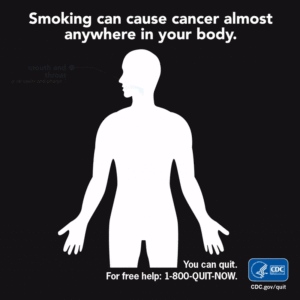Smoking is the leading cause of preventable death in the United States, causing 480,000 deaths every single year.
The average cloud of smoke from tobacco has over 7000 chemicals. Of those chemicals, 250 are harmful and at least 69 can cause cancer. These chemicals go from the lungs into the bloodstream and can cause damage to nearly every organ in the body.
If you are a parent looking for resources to help a child that might be struggling with a vaping or tobacco addiction, visit our Vaping Prevention and Cessation Resources for Parents webpage.
- Nicotine is very addictive which causes people to smoke, vape, or chew tobacco over and over again.
- Nicotine withdrawal symptoms can be very unpleasant and can mimic symptoms of anxiety or depression.
- A pack a day smoker repeats the hand to mouth motion nearly 95,000 times in a year which also builds a strong pattern in the brain, in addition to the chemical addiction to nicotine.
- The more you repeat tobacco use, the higher the chances that it causes damage to your body.
- Nicotine withdrawal can start within 4 hours after the last time you had nicotine and typically symptoms are most intense on day 2 or 3 of quitting. After that, symptoms should get better each day for the next 3 to 4 weeks. Nicotine withdrawal looks like:
- Feeling frustrated, irritable, or angry
- Feeling sad or depressed
- Feeling anxious or jumpy
- Difficulty concentrating
- Difficulty sleeping
- Increased appetite
- Cravings for nicotine.
- Headaches, nausea, dizziness, constipation, dry mouth and a sore throat are less common withdrawal symptoms
- 30% of all cancer deaths and 80% of lung cancers are caused by smoking which makes quitting one of the best ways to reduce your cancer risk.
- Even light smoking causes damage to the lungs and leads to worse health outcomes across all areas of health.
- Chemicals from smoking travel from the lungs into the bloodstream which then transport them all throughout the body. As a result, this can cause cancer and other damage throughout nearly every organ of the body.
- Nicotine is considered a tumor promoter and can make cancers more aggressive.
- Smoking damages immune function, which is your body’s way of finding and fighting off harmful things like bacteria, viruses, and toxins, making the smoker more vulnerable to all kinds of illnesses.
- Smokers are more likely to get respiratory infections like the flu, colds, and COVID-19 as well as get more severe and longer-lasting illnesses.
- Smoking reduces the effectiveness of vaccines that are meant to prevent illnesses such as the flu, pneumonia, and COVID-19.
- Tobacco use makes the heart work harder and increases the likelihood of cardiovascular issues.
- Using tobacco increases blood pressure, damages blood vessel lining, reduces oxygen supply to the heart, promotes blood clots, and contributes to plaque buildup in arteries, which can lead to heart attacks and stroke.
- Tobacco smoke contains thousands of dangerous chemicals that enter your lungs and bloodstream that cause your heart to beat faster and increase levels of “bad” LDL cholesterol, blood pressure, and chances of blood clots which can lead to a stroke.
- High blood pressure is linked to half of all strokes.
- Smoking is the main cause of chronic obstructive pulmonary disease (COPD), a serious lung condition that makes it hard to breathe.
- COPD includes diseases like chronic bronchitis and emphysema, both of which damage your lungs over time; once air sacs are destroyed, they can’t grow back, making the damage permanent. There is no cure for COPD.
- COPD can be prevented by not smoking; quitting smoking slows down its progress.
- COPD is one of the top 10 causes of early death in the United States.
- Smoking is the leading cause of lung cancer, responsible for 80–90% of lung cancer deaths in the United States.
- Smoking cigarettes, cigars, pipes, or other tobacco products increases the risk of lung cancer.
- Even smoking a few cigarettes a day or occasionally increases the risk of heart disease, respiratory disease, and cancer.
- Smoking increases the risk of Type 2 diabetes by 30-40%.
- Smoking worsens diabetes health complications.
- Smoking damages blood vessels, slowing blood flow and increasing risk of infections and ulcers.
- Nicotine makes it harder for your body to respond to insulin; this increases blood glucose levels.
- High levels of nicotine reduces the body’s responsiveness to insulin; which may require the person to need higher doses of insulin.
- Heavy smokers tend to have higher midsection/belly fat due to insulin resistance.
- Smoking and vaping keep your body from getting as much oxygen which makes it harder for your body to heal itself. This contributes to gum disease which, in severe cases, can make your teeth fall out.
- Nicotine can damage your oral health in several ways:
- Limits infection fighting ability
- Limits blood flow to the gums
- Slows connective tissue rebuilding
- Nicotine is also a tumor promoter which can make cancers more aggressive.
- In addition to damage from nicotine, the other ingredients in vapes can impact oral health:
- Propylene glycol dries out the mouth, which allows more bacteria to grow on teeth. It also can damage enamel and irritate soft tissue.
- Vegetable Glycerin combines with flavorings to cause 4 times as many microbes to stick to teeth and can double biofilm growth.
- Sweet and sugary flavorings combine with the ingredients above and can worsen oral health problems.
- Aerosols from vapes can increase inflammation and cause DNA damage.
- Nicotine pouches and chewing tobacco (dip, snuff, chew) can cause damage to the mouth:
- In addition to the damage from nicotine, these pouches can cause mouth sores and ulcers, as well as inflammation that can cause cavities and gum recession. These products are very new so there may be other health effects we don’t know about yet.
- Chewing tobacco can cause cancers in the pancreas, esophagus, mouth, tongue, cheek and gums.
- Dip, snuff and chewing tobacco can also stain teeth, cause inflammation and tooth decay.
- Some signs of oral health problems from tobacco products are:
- Gums that are red, swollen, tender or bleeding
- Painful chewing
- Loose teeth or sensitive teeth
- Bad breath
- Mouth ulcers
- For men, smoking causes erectile dysfunction and can damage sperm.
- For pregnant women, smoking can cause:
- Fertility problems
- Increased risk of miscarriage and ectopic pregnancy
- Increased risk for SIDS (Sudden Infant Death Syndrome)
- The baby is also more likely to be born too early, at a low birth weight, or with a cleft lip or cleft palate.
- 7300 lung cancer deaths each year are due to secondhand smoke.
- Living with a smoker can increase a non-smokers risk by 20-30% for diseases such as:
- Lung Cancer
- Heart disease
- Stroke
- Children who are near secondhand smoke have a higher risk for:
- Ear infections
- Colds
- Pneumonia
- Bronchitis
- Asthma symptoms may be more severe and more often
- Slows the growth of a child’s lungs
- Causes coughing, wheezing, and feeling breathless
- All tobacco products have nicotine which is addictive. Even without all the other chemicals found in cigarettes, nicotine can still:
- Increase anxiety & depression symptoms
- Harm brain development related to attention and learning
- Increase blood pressure and can contribute to hypertension
- Cause nausea, vomiting, diarrhea, and abdominal pain
- Most other forms of tobacco are absorbed orally (through the mouth). Nicotine causes damage to your mouth in a few different ways:
- Limits infection fighting ability
- Limits blood flow to the gums
- Slows connective tissue rebuilding
- Vaping can cause a variety of health effects. See our vaping page to learn more.
- Chewing tobacco can cause cancers in the pancreas, esophagus, mouth, tongue, cheek and gums.
- Cigars, Pipe Smoking, Hookahs (or waterpipes) and Bidis are all known to cause cancers in the lungs, mouth, throat, larynx, and esophagus.
- Cigars have higher levels of toxic chemicals than cigarette smoke but the smoke is often not inhaled. Other risks include:
- Heart disease
- Other types of lung disease
- Cancer of the mouth, larynx, esophagus, lung, and pancreas
- Pipe smoking – the smoke from pipe smoking is also usually not inhaled but can cause cancers (see above).
- Hookah or waterpipe – the smoke from hookah is just as toxic as cigarette smoke.
- Bidis are associated with heart attacks in addition to cancers listed above.
- Benefits of Quitting Smoking
- COPD
- Cardiovascular Toxicity of Nicotine: Implications for Electronic Cigarette Use
- Diabetes and Smoking
- E-cigarettes and Vaping
- 4 Ways Vaping Can Ruin Your Teen’s Smile
- Harmful Effects of Nicotine
- Harms of Cigarette Smoking and Health Benefits of Quitting
- Health Effects of Cigarettes: Reproductive Health
- High Blood Pressure
- How Smoking and Nicotine Damage Your Body
- How Smoking Can Increase Your Risk and Affect Diabetes
- How Tobacco Use Affects Oral Health
- Is Nicotine Addictive?
- Light smoking: Dangerous in Any Dose
- Lung Cancer Risk Factors
- Need Another Reason Not to Vape? Your Oral Health is at Risk
- Nicotine Withdrawal: Symptoms, Treatment & Side Effects
- Public Health Consequences of E-Cigarettes
- 7 Common Withdrawal Symptoms
- Smoking and Diabetes
- Smoking and Mental Health
- Smoking, Gum Disease, and Tooth Loss
- Smoking Increases the Risk of Illness and Viral Infection, Including Type of Coronavirus
- Stay Away from Tobacco
- 10 Health Effects Caused by Smoking You Didn’t Know About
- Understanding Smoking and Stroke
- What is COPD?


